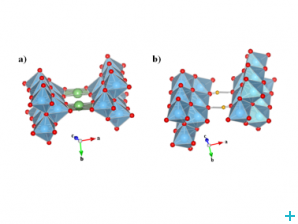Investigating a new material for lithium rechargeable batteries
By J. C. Pérez-Flores, C. Baehtz, M. Hoelzel, A. Kuhn and F. García-Alvarado, 10.06.2013
The existence of the protonated hexatitanate H2Ti6O13 was only very recently demonstrated, even though only a partial characterisation has been accomplished. Our analysis of data from synchrotron and neutron powder diffraction, combined with IR spectroscopy data, provided us with a precise determination of the crystal structure, thus shedding light on the electrochemical properties of the material and the charge and discharge processes. H2Ti6O13 finally revealed itself to be an interesting material for rechargeable lithium batteries.
Neutrons: indispensible tools to analyse structure
After synthesising H2TiO13 by Li+/H+ ion exchange on Li2Ti6O13 at mild temperature we used powder X-ray diffraction for a preliminary structural characterisation. We went on to characterise the structure in more detail, using neutron powder diffraction at the Heinz Maier-Leibnitz neutron source (FRM II, Garching, Germany), thanks to NMI3 funding. Additional synchrotron diffraction experiments were performed at the Helmholtz-Zentrum Dresden-Rossendorf outstation in the European Synchrotron Radiation Facility in Grenoble, France. To complete our work, we investigated the lithium insertion/deinsertion processes electrochemically.
Shedding light on H2Ti6O13
Whilst X-ray diffraction using synchrotron radiation provides highly accurate phase analysis, neutron diffraction is indispensable for deeper investigations, as both Li and H atoms can be readily located within the structure using subtle intensity changes in the neutron diffraction patterns. We fitted the neutron diffraction data obtained for both parent and proton exchanged derivatives to first refine a structural model without Li or H, respectively. The results suggest that the “skeleton” of this material, [Ti6O13]-2 is preserved during the successive exchange reactions, with very fine changes. For example, H2Ti6O13 exhibits small shrinking of the a and b axes, while the c axis increases upon ion exchange with protons. The combined but opposite trends in lattice parameters lead to a relatively small decrease in unit cell volume. However, the a and c directions were mainly affected by the Li+/H+ ion exchange due to a change in the tunnel space (see figure).
The properties of H2Ti6O13 seem to surpass those of the parent compound Li2Ti6O13. Its reversible capacity is well maintained upon cycling, even at increasing discharge rates. Furthermore, this reversible capacity is similar to that obtained for other titanium oxides already proposed as anode material for lithium rechargeable batteries. We would therefore propose both these materials as candidates for anode material, once their electrochemical performance is optimised.
The future of rechargeable lithium batteries
These results represent a significant step forward, furthering our understanding of the electrochemical behaviour of these materials and confirming their potential in the future development of rechargeable lithium batteries.
Publications
- J. C. Pérez-Flores et al., RSC Advances, 2(8), 3530-3540, 2012
- J. C. Pérez-Flores, A. Kuhn & F. García-Alvarado, J Power Sources, 196, 1378–1385, 2011
- J. C. Pérez-Flores et al., Phys. Chem. Chem. Phys., 14, 2892–2899, 2012
- J. C. Pérez-Flores et al., Dalton Trans., 41, 14633-14642, 2013

Alois Kuhn from the San Pablo University in Madrid, Spain, received NMI3 support to perform experiments at FRM II in Garching, Germany.

